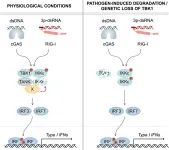(Press-News.org) Prenatal exposure to an anti-nausea drug commonly used in the 1960s and 1970s has been shown to increase risk of colorectal cancer in adult offspring, according to a study by researchers at UTHealth Houston.
The study, led by Caitlin Murphy, PhD, MPH, associate professor at UTHealth Houston School of Public Health, was published today in JNCI Cancer Spectrum.
Incidence rates of colorectal cancer are increasing among adults born in and after the 1960s, which Murphy said implicates pregnancy-related exposures introduced at that time as risk factors. Dicyclomine – used to treat spasms caused by irritable bowel syndrome – was initially included in Bendectin, a drug prescribed during pregnancy in the 1960s to prevent nausea and vomiting.
“Our findings suggest that events in the earliest periods of life – including the womb – can affect risk of cancer many decades later,” said Murphy, who was first author on the study. “As many as 25% of pregnant women received Bendectin through the mid-1970s, and there may be long-lasting consequences for offspring that continue today.”
The researchers analyzed data from Child Health and Development Studies, a multi-generational cohort that enrolled more than 14,500 pregnant women (who bore 18,751 offspring) in Oakland, California, between 1959 and 1967. Through medical records, they determined that about 5% of offspring, or 1,014 children, were exposed in utero to Bendectin.
Per 10,000 offspring, incidence rates of colorectal cancer were three times as high in those exposed to Bendectin compared to offspring not exposed.
Murphy believes the higher risk of colorectal cancer in offspring exposed to the drug may be driven by dicyclomine, which was contained in the three-part formulation of Bendectin used during the 1960s. It is suspected that dicyclomine may directly target the developing gastrointestinal tract of the fetus, she said, adding that some studies suggest infants born to women who received Bendectin during pregnancy are more likely to have gastrointestinal birth defects.
After reports of birth defects and concerns in the wake of the thalidomide tragedy, the manufacturer removed dicyclomine from the drug’s formula in 1976. Pregnant women in the late 1950s and early 1960s were prescribed a drug containing thalidomide to relieve morning sickness, which led to a scandal when more than 10,000 offspring were born with a range of severe deformities.
Still, Murphy said experimental studies are needed to clarify these findings and identify mechanisms of risk.
“Dicyclomine is still used in clinical practice to treat irritable bowel syndrome. It is designated as Pregnancy Category B by the U.S. Food and Drug Administration, meaning there are not adequate studies of pregnant women to determine risk to the fetus,” she said. “Medications prescribed to pregnant women may contribute to higher rates of cancer among offspring exposed in the womb.”
Barbara A. Cohn, PhD, with the Public Health Institute in Berkeley, California, was senior author of the study. Co-authors from the Public Health Institute were Piera M. Cirillo, MPH, and Nickilou Y. Krigbaum, MPH. Amit G. Singal, MD, with UT Southwestern Medical Center in Dallas, also contributed.
END
Prenatal exposure to anti-nausea drug in ‘60s, ‘70s tied to increased risk of colorectal cancer
2023-03-10
ELSE PRESS RELEASES FROM THIS DATE:
Wayne State researcher publishes new research to bring Brillouin microscopy closer to widespread use in diagnostic medicine
2023-03-10
Diagnostic imaging offers physicians and scientists critical visual representations of internal body structures, greatly enhancing clinical analysis and medical intervention. Researchers continue to break new ground on how various imaging technologies can provide a better understanding of human health.
Jitao Zhang, assistant professor of biomedical engineering (BME) at Wayne State University and a scientific member of the Karmanos Cancer Institute’s Molecular Imaging Program, is an award-winning researcher who holds three patents on a novel imaging technique called Brillouin microscopy ...
By studying sediment, UTA researcher will help stabilize Texas shorelines
2023-03-10
A University of Texas at Arlington civil engineering researcher is filling in an information gap for the state by determining how much sediment is lost by Texas rivers to the ocean.
Yu Zhang, associate professor in the Department of Civil Engineering, received a $150,000 Texas Water Development Board grant to assess the amount of sediment transported from Texas rivers to the Gulf of Mexico. The project is titled “Best Practices in Modeling Sediment Transport and Budget Along Texas Coast.” He and his team will also work with the General Land Office to develop a Sediment Management Plan for the state.
Zhang said the Brazos River is ...
Meta-analysis shows association between autism in children and cardiometabolic diseases
2023-03-10
A study conducted by the Centers for Disease Control and Prevention (CDC) from 2009 to 2017 determined that approximately 1 in 44 children ages 3-17 are diagnosed with some form of autism spectrum disorder (ASD). Research also has established that children with ASD have an increased risk of obesity, and obesity has been linked to increased risks for cardiometabolic disorders such as diabetes and dyslipidemia (high level of cholesterol or fat in the blood). However, the question of whether or not there is an association between autism, cardiometabolic disorders and obesity remains largely unanswered.
To help provide an insight ...
Microbes can create a more peaceful world: Scientists call to action
2023-03-10
Microorganisms should be ‘weaponised’ to stave off conflicts across the globe, according to a team of eminent microbiologists.
The paper ‘Weaponising microbes for peace’ by Anand et al, outlines the ways in which microbes and microbial technologies can be used to tackle global and local challenges that could otherwise lead to conflict, but warns that these resources have been severely underexploited to date.
Professor Kenneth Timmis, Founding Editor of AMI journals Environmental Microbiology, Environmental Microbiology Reports and ...
University of Freiburg establishes Eva Mayr-Stihl Chair for Multi-Scale Characterization of Materials Systems
2023-03-10
New analytical methods and approaches to research are enhancing sustainability and materials research with particular reference to engineering science/technology at the University of Freiburg: Dr. Oana Cojocaru-Mirédin is taking on the new Eva Mayr-Stihl Chair for Multi-Scale Characterization of Materials Systems which has been established at the University’s Department of Sustainable Systems Engineering (INATECH).
Cojocaru-Mirédin, who previously researched and taught at RWTH Aachen, specializes in the application of various characterization techniques in the study of materials ...
Immune cells have a backup mechanism
2023-03-10
The enzyme TBK1 is an important component of the innate immune system that plays a critical role in the defense against viruses. Upon mutation-induced loss of TBK1 function, patients show an increased susceptibility to viral infections. Strikingly, if TBK1 is not expressed at all, this clinical effect is not seen. The mechanism behind this supposed discrepancy has now been elucidated by researchers led by Prof. Martin Schlee from the University Hospital Bonn and the Cluster of Excellence ImmunoSensation2 at the University of Bonn. The study was published in the journal Frontiers in Immunology.
In the human body, viral particles are ...
Researchers discover therapeutic target to aid in glaucoma treatment
2023-03-10
INDIANAPOLIS—Indiana University School of Medicine researchers have identified a new therapeutic target that could lead to more effective treatment of glaucoma.
Glaucoma is a neurodegenerative disease that causes vision loss and blindness due to a damaged optic nerve. More than 200,000 people are affected by glaucoma in the United States each year. Unfortunately, there is currently no treatment. In a newly published paper in Communications Biology, researchers found neurons use mitochondria for a steady source of energy, and restoring mitochondrial homeostasis in the diseased neurons can protect the optic nerve cells from being damaged.
“Age-related ...
Medicaid expansion reduced black-white disparities in preventable hospital visits
2023-03-10
Expanding Medicaid-benefit eligibility to cover all people with income below 139 percent of the federal poverty line reduced Black-white disparities in preventable hospitalizations and emergency department (ED) visits, according to research from Rutgers University and the U.S. Agency for Healthcare Research and Quality.
The analysis of state-level inpatient and ED data from 2011 to 2018 showed that such disparities fell 10 percent or more in states that expanded eligibility compared to states that continued with older, stricter requirements.
Benefit expansion didn’t affect the relatively smaller disparities in preventable hospitalizations and ED visits between ...
New study challenges our understanding of the immune system
2023-03-10
A recently published study from Aarhus University may mean a textbook chapter on the immune system will have to be rewritten.
In the study, published in the journal Nature Communications, the researchers reveal crucial new knowledge about B cells, which form a vital element in the body’s defence system. B cells are the cells that generate protective antibodies when we are vaccinated or have an infection – and it is also the B cells that produce harmful antibodies in connection with allergies or autoimmune diseases.
The researchers have examined the earliest step ...
University of Cincinnati researchers develop innovative breathing aid
2023-03-10
One in 10 adults suffer from the debilitating effects of chronic obstructive pulmonary disease (COPD). Research around a new breathing device developed by pulmonologists at the University of Cincinnati offers promise for improving their lives.
The new device not only improves symptoms of breathlessness and quality of life for people with COPD, it also offers benefits for people dealing with stress and anxiety and those practicing mindfulness, meditation or yoga.
The research was published in the journal Respiratory Care.
The device, called PEP Buddy, was created by Muhammad Ahsan Zafar, MD, and Ralph Panos, MD. Zafar is an associate professor in the Department of Pulmonary Critical ...






